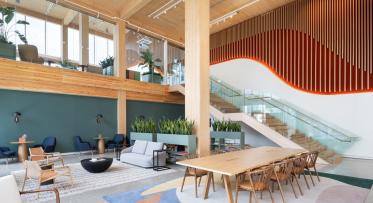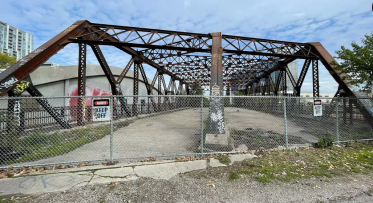The Future of Waterfront Revitalization: Aspirational Projects
This conceptual map represents new connectivity to more destinations across the Toronto waterfront. (Click here for larger version).
POSTED: MAY 6, 2019 I PARKS AND PUBLIC REALM, TRANSPORTATION, DESIGN, INFRASTRUCTURE, ECONOMIC DEVELOPMENT
By: Meghan Hogan
We’ve reached the final post in this series that unpacks big goals in Waterfront Toronto’s new Five-Year Strategic Plan; a blueprint for the next five years of waterfront revitalization. Previously, we examined the history of Toronto’s waterfront and the events that led to the creation of Waterfront Toronto, and explored a roster of more than 20 priority projects we intend to deliver in the next five years along with how we are imagining Canada’s next generation community.
In this post, we dive into our third strategic goal for the next five years: exploring signature projects that will put Toronto on the global map…
Lessons learned around the world

Last year, we identified a list of 40 attributes from successful waterfront’s around the world that helped inform our four aspirational projects over the next five years. (Click here for larger version)
Since 2001, we’ve successfully transformed the Toronto waterfront from an inaccessible and derelict space into thriving communities by creating an accessible and active space for living, working, and playing. Now our goal is to make the waterfront one of the top urban waterfronts in the world.
To achieve this, we began by analyzing the attributes of some of the world’s most iconic waterfronts to better understand what has made them successful – not to mimic their success but rather to learn from them. Regularly ranked among the best are Stockholm, Amsterdam, Singapore, Chicago and Rio de Janeiro, each with attributes that attract millions of people each year. From instantly recognizable architecture and bridge networks, to streetscape character, continuous promenades and architectural icons, we identified a series of 40 attributes that are powerful benchmarks of success.
We then gathered public feedback on what Torontonians would like to see from this list on our own waterfront. Four priorities emerged that we intend to explore over the next five years to move Toronto’s waterfront to the next level of revitalization and unlock its position as a global waterfront destination. Keep reading to learn more.
1. Jack Layton Ferry Terminal
 An artists’ rendering of the expanded Jack Layton Ferry Terminal and Harbour Square Park.
An artists’ rendering of the expanded Jack Layton Ferry Terminal and Harbour Square Park.
One of our goals for the waterfront is to boost mobility and create more urban connections across the harbour and broader city. The Jack Layton Ferry Terminal currently serves the important function of moving passengers to and from the Toronto Islands, but its service is constrained by the size of the ferries and the terminal building itself.
In 2015, Waterfront Toronto, in partnership with the City of Toronto, launched an international design competition to establish a compelling vision for an expanded Jack Layton Ferry Terminal and adjacent Harbour Square Park. We recently completed construction on Phase 1A of the project which features a new granite entrance promenade that ties into the design of the revitalized Queens Quay.
Over the next five years, we plan to collaborate with City of Toronto Parks, Forestry and Recreation to study potential funding and financing models that could help us begin future phases of construction and make the full vision for the Jack Layton Ferry Terminal and Harbour Square Park a reality.
2. Continuous Waterfront Walk
 The revitalized Queens Quay features a generous pedestrian promenade, a multi-use recreational trail and a series of WaveDecks designed to make the waterfront more accessible and connected. (Image by Nicola Betts).
The revitalized Queens Quay features a generous pedestrian promenade, a multi-use recreational trail and a series of WaveDecks designed to make the waterfront more accessible and connected. (Image by Nicola Betts).
Using the list of 40 attributes from successful waterfronts around the world, we asked the public what they would like to see replicated in Toronto. More than 44 per cent of people we surveyed identified a well-connected waterfront and continuous promenade as a top priority for the future of Toronto’s waterfront. It’s also one of the most common features found on signature waterfronts around the world.
Our work to date has already dramatically expanded the number of places where people can access the water’s edge: on promenades, on play structures like the WaveDecks, or on the nearly six kilometres we’ve added to the Martin Goodman Trail. But connectivity around the harbour remains limited and there is huge opportunity to fill the gaps between destinations along the waterfront.
Our goal over the next five years is to explore the possibility of designing and constructing a continuous waterfront walk from the Portland Slip in the west to the Parliament Slip in the East, connecting into the naturalized Don River. Not only would this make the shore an even more active and inviting space, but it would help the waterfront move towards a more cohesive and connected destination.
3. Destination Playground
 A rendering of one possible approach to the Destination Playground project at Promontory Park in the Port Lands.
A rendering of one possible approach to the Destination Playground project at Promontory Park in the Port Lands.
The concept of a destination playground is relatively new and can most easily be described as a large, immersive play environment with local ecosystems designed to entertain people of all ages and abilities. Destination playgrounds are growing in popularity across the globe partly due to a growing body of evidence that indicates nature play can have powerful positive effects on children’s health and development.
An excellent example of a destination playground is Maggie Daley Park on the Chicago waterfront – an incredible landscape that draws in millions of residents and visitors yearly thanks to its engaging and accessible features.
In the Toronto Port Lands, we envision a 3.6-acre destination play area in Promontory Park with distinct zones tailored to children at different developmental stages. Over the next five years, we’ll collaborate with the City of Toronto Parks, Forestry and Recreation division to seek alternative funding to help bring this unique vision to life.
4. Iconic Cultural Destination
The Sydney Opera House (top) and Elbe Philharmonic Hall in Hamburg (bottom) are two prominent examples of iconic cultural waterfront destinations. (Images from Wikipedia)
Many of the world’s most successful waterfronts have bold structures that not only anchor local economic and cultural activities but are visual icons. For example, the Sydney Opera House, the Elbe Philharmonic Hall in Hamburg, and the EYE Film Institute in Amsterdam have all come to define a unique identity for their respective cities.
Over the next five years, we plan to assess the potential for a distinctive structure that will provide a magnetic gathering place, activate the surrounding public realm, catalyze new economic clusters and capture Toronto’s identity. This includes consulting with the public and potential partners to determine if there is an appetite for this project, what it might look like and how to make it financially possible.
One possibility for a landmark structure that we envision could be an innovative sustainable building that houses a centre of excellence in a distinct field or discipline. It could also be an architecturally significant building that showcases Canadian leadership in an important area.
Hear from Waterfront Toronto's leadership team
Last month, the Toronto Region Board of Trade welcomed Waterfront Toronto on stage to chat about our recently released Five-Year Strategic Plan. We invite you to watch the discussion to hear about where we began, what we've accomplished so far and the future of waterfront revitalization.






